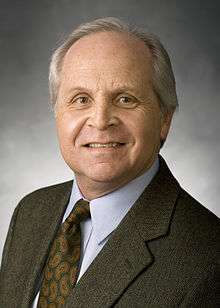Gregory Clark (rhetorician)

Gregory Clark (born 1950 in Provo, Utah) is an American scholar and teacher working in rhetorical studies and American cultural criticism. His project is both theoretical and critical, developing concepts of how influence works that he then uses to study capacities for influence inherent in American cultural practices.[1]
His theoretical project centers on an ongoing exploration of rhetorical aesthetics: ways that rhetoric works through aesthetic means and ways that aesthetic encounters do rhetorical work. Clark's primary resource for this work is the work of Kenneth Burke. His critical project has examined early American literature and oratory, American landscapes, and now is focusing on American music in order to trace ways the experiences they provide shape American identity. In 2015 he began an ongoing project pianist and composer, Marcus Roberts, to teach and demonstrate democratic practices of personal and civic interaction through the model of jazz music.
Clark is Professor of English at Brigham Young University where he has led the American Studies and University Writing programs and chaired the English Department and served as associate dean in the College of Humanities. He teaches courses in rhetorical theory, composition theory, and rhetoric and leadership. He has also taught periodically in the graduate program in rhetoric and writing at University of Utah.
Gregory Clark has been a leader in the Rhetoric Society of America, serving as a member of the Board (1996-1998), Editor of Rhetoric Society Quarterly (2000–2007), and Executive Director (2008-2012). In July 2016 he became President .
In 2011 Gregory Clark was appointed as the inaugural fellow of the National Jazz Museum in Harlem . In 2012 he was awarded the University Professorship at Brigham Young University. In
Publications
- Gregory Clark's books
- Civic Jazz: American Music and Kenneth Burke on the Art of Getting Along (University of Chicago Press, 2015)
- Trained Capacities: John Dewey, Rhetoric, and Democratic Practice, with Brian Jackson. (University of South Carolina Press, 2014)
- Rhetorical Landscapes in America: Variations on a Theme by Kenneth Burke (University of South Carolina Press, 2004)
- Oratorical Culture in America: Essays on the Transformation of Nineteenth-Century Rhetoric, with S. Michael Halloran. (Southern Illinois University Press, 1993)
- Dialogue, Dialectic, and Conversation: A Social Perspective on the Function of Writing (Southern Illinois University Press, 1990)
- Recent articles and chapters
- “’A Child Born of the Land’: The Rhetorical Aesthetic of Hawaiian Song.” Rhetoric Society Quarterly 42:3 (July 2012), 251-270.
- “Remembering Zion: Architectural Encounters in a National Park,” 29-54. Observation Points: The Visual Poetics of National Parks, ed. Thomas Patin. University of Minnesota Press, 2012.
- “Experiencing Democratic Identity: Paul Woodruff’s Reverence, First Democracy, and The Necessity of Theatre,” Rhetoric Society Quarterly 41:1 (Winter 2011), 75-85.
- “Rhetorical Experience and The Jazz Museum in Harlem,” 113-135. Places of Public Memory: The Rhetoric of Museums and Memorials, ed. Greg Dickinson, Brian L. Ott, and Carole Blair. University of Alabama Press, 2010
- “National Park Landscapes and the Rhetorical Display of a Civic Religion,” with S. Michael Halloran. 141-156. Rhetorics of Display, ed. Lawrence Prelli. University of South Carolina Press, 2006
- “‘Tossing’ and ‘Eye-Crossing’: Apprehensive in the American Landscape.” KB Journal 2:2 (Spring 2006). Special issue, “Kenneth Burke and Ecocriticism,” ed. Robert Wess. http://kbjournal.org/spring2006
- “Virtuosos and Ensembles: Rhetorical Lessons from Jazz,” 31-46. The Private, the Public, and the Published: Reconciling Private Lives and Public Rhetoric, ed. Barbara Couture and Thomas Kent. Utah State University Press, 2004.
References
- ↑ Clausen, Lisbeth (2003). Global News Production. Copenhagen Business School Press DK. p. 125. ISBN 9788763001106. Retrieved 8 November 2014.